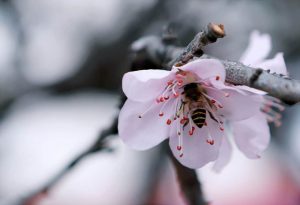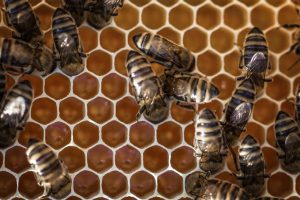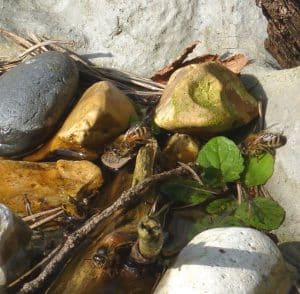The Buzz about Honeybees and Water
Signs of spring are everywhere. Flowers are blooming, leaves are budding on trees, and sneeze-inducing pollen is abundant.

Spring is also the start of beekeeping season. As one of our most important pollinators for our food crops, the health and survival of honeybees is vital to our ecosystem.
Just like all living things, bees need food and water. Honeybees however, cannot simply turn on a faucet for a drink and they rarely store water. Instead, honeybees must forage for water, bringing it into their colonies as needed, as they do pollen, nectar and propolis for their survival.
How Bees Use Water
There are several uses for water in a bee colony.
For brood to develop properly, the hive requires a constant temperature of approximately 94°F and relative humidity of 50-60%. Worker bees spread gathered water droplets on the rims of honeycomb cells, on top of sealed brood, and along the hive walls. To regulate the temperature and humidity in the hive, bees will fan their wings to evaporate the water to cool the hive—similar to how we use air conditioners to cool our own homes in the summer.

Nurse bees, who feed the developing eggs, larvae and pupae, also have a high demand for water. The nurses attending the brood, consume copious amounts of water, pollen, and nectar so that their hypopharyngeal glands can produce royal jelly used to feed the eggs. As the larvae develops, they are fed diluted honey, nectar, and pollen.
Honeybees make honey as a means of storing food to eat. This is especially important in the winter months when bees can’t forage for nectar and rely on stored honey for food. But before bees can easily consume honey, it first must be diluted. Bees add water to dilute honey to 50% moisture. Honey will also crystallize if the temperature drops below 50ºF. Bees use water to dilute the crystals back into liquid before they can eat it.
Where Bees Find Water
Bees find water in a number of places, often lining up on the edges of birdbaths, mud puddles, damp rocks, branches, and drops clinging to vegetation. Foraging bees swallow the water and store it in their crops before flying home. The water is then transferred to waiting worker bees in the hive—a process known as trophallaxis—the direct transfer from one bee to another.

It has been estimated that under really hot and dry temperatures, bees may bring back nearly a gallon of water each day to their hives.
As honeybees search for water, they often find water in agricultural areas—runoffs in ditches, culverts, or stormwater in waterways—that may contains insecticides, pesticides or fungicides. Plants sprayed with pesticides or treated with systemic insecticides exude sap and form drops on the tips of stems and leaves that bees consume. These toxins, brought back to the hive can impair bee development, contaminate honey, and sadly, can completely destroy a bee colony.
Clean water supplies are essential for the operation and survival of honeybee colonies.
Creating Water Sources for Bees
Fortunately, bees are not too picky about the type water they need. Bees tend to select the most fragrant, nutrient-rich water sources they can find. It could be the odor of mud, leaf tannin, mold, bacteria, or even chlorine from nearby swimming pools that attract bees. Minerals, salts, and other natural organic materials found in water adds important nutrients and vitamins to the bee diet.

It is widely thought it is the scent of the source that helps bees find water. Foragers will also mark unscented sources of water with their bee pheromones to communicate to others where to find these resources.
Providing fresh sources of water is easy to do. Water can be left in shallow trays, birdbaths, flower pots, and bowls—just about anything that will hold water. Bees don’t like to get their feet wet and cannot swim. So, remember to add small stones, sticks, and other floating materials, such as cork to these containers. This will allow bees to safely stand near the water source without drowning.
And, eliminate the use of systemic and applied pesticides, insecticides and fungicides—not only for the health and welfare of bees but for our own health and the environment. Pesticides and other chemicals applied to farmlands, gardens and lawns can make their way into ground water or surface water systems that feed drinking water supplies.
As the weather heats up and the days turn hot and lazy, the bees will be busy. Honeybees will travel incredible distances for their food and water, often flying two miles or more visiting 50 to 100 flowers each trip and returning to the hive as many as twelve times a day. A single bee colony can pollinate up to 300 million flowers a day. As a vital part of our food source, bees also pollinate 70 of the top 100 food crops we eat.
So, help our little pollinators by providing sources of fresh water.
